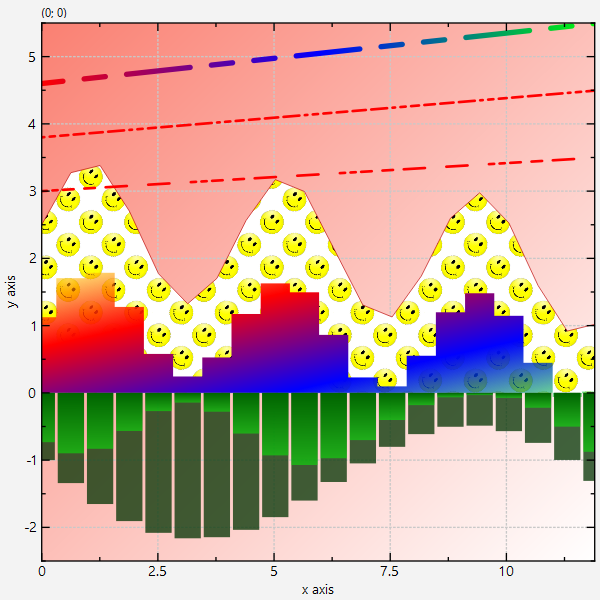mirror of
https://github.com/jkriege2/JKQtPlotter.git
synced 2025-01-15 02:02:10 +08:00
- for Qt 5.15: added missing #include statements that became necessary since Qt 5.15 - for Qt 5.15: fixed use of several deprecated functions - for Qt 5.15/6: removed usage of QMatrix
111 lines
4.7 KiB
Markdown
111 lines
4.7 KiB
Markdown
# Example (JKQTPlotter): Advanced Line and Fill Styling {#JKQTPlotterAdvancedLineAndFillStyling}
|
|
This project (see `./examples/advplotstyling/`) demonstrates how to use advanced line styling and filling options (e.g. custom dash-styles, gradient, image fills, transparencies, ...) with JKQtPlotter.
|
|
|
|
The source code of the main application can be found in [`advplotstyling.cpp`](https://github.com/jkriege2/JKQtPlotter/tree/master/examples/advplotstyling/advplotstyling.cpp).
|
|
|
|
Initially several data columns are generated and added to the internal datastore. Then several line graphs are added that all use different custom dashes. In addition the third line does not use a single color, but a gradient for coloring:
|
|
```.cpp
|
|
JKQTPGeoLine* graphL1=new JKQTPGeoLine(&plot, 0, 3, 12, 3.5, Qt::red);
|
|
JKQTPGeoLine* graphL2=new JKQTPGeoLine(&plot, 0, 3.8, 12, 4.5, Qt::red);
|
|
JKQTPGeoLine* graphL3=new JKQTPGeoLine(&plot, 0, 4.6, 12, 5.5, Qt::red);
|
|
|
|
// 5.2 set advanced line style (see also https://doc.qt.io/qt-5/qpen.html#setDashPattern)
|
|
// and use a gradient-brush to fill the last (thicker) line
|
|
QVector<qreal> dashes1;
|
|
dashes1 << 2 << 2 << 2 << 2 << 4 << 4 << 4 << 4 << 8 << 8 << 8 << 8 ;
|
|
graphL1->setLineDashPattern(dashes1);
|
|
graphL1->setLineWidth(2);
|
|
QVector<qreal> dashes2;
|
|
dashes2 << 1 << 2 << 2 << 2 << 3 << 2 << 4 << 2 << 5 << 2 << 6 << 2 ;
|
|
graphL2->setLineDashPattern(dashes2);
|
|
graphL2->setLineWidth(2);
|
|
QVector<qreal> dashes3;
|
|
dashes3 << 4 << 4 << 4 << 4 << 12 << 4 ;
|
|
graphL3->setLineDashPattern(dashes3);
|
|
graphL3->setLineWidth(4);
|
|
QLinearGradient lineGrad(QPointF(0, 0), QPointF(1, 0));
|
|
lineGrad.setColorAt(0, Qt::red);
|
|
lineGrad.setColorAt(1, Qt::green);
|
|
lineGrad.setCoordinateMode(QGradient::ObjectBoundingMode);
|
|
graphL3->setLineBrush(lineGrad);
|
|
```
|
|
|
|
In addition, a `JKQTPSpecialLineHorizontalGraph` is filled using an image `example.bmp` as a texture:
|
|
```.cpp
|
|
JKQTPSpecialLineHorizontalGraph* graphF=new JKQTPSpecialLineHorizontalGraph(&plot);
|
|
|
|
// 5.2 set fill style, using an image, also rotate the images
|
|
graphF->setSpecialLineType(JKQTPDirectLine);
|
|
graphF->setDrawLine(true);
|
|
graphF->setFillTexture(QPixmap(":/example.bmp"));
|
|
graphF->setFillTransform(QTransform(0.5,0,0,0.5,0,0).rotate(45));
|
|
graphF->setFillCurve(true);
|
|
graphF->setLineWidth(0.5);
|
|
```
|
|
|
|
This texture-filled graph is overlayn by a graph filled with a color gradient that is semi-transparent in some colors:
|
|
|
|
```.cpp
|
|
JKQTPSpecialLineHorizontalGraph* graphF2=new JKQTPSpecialLineHorizontalGraph(&plot);
|
|
|
|
// 5.3 set fill style, using a custom linear gradient, also with changing transparency (alpha) values
|
|
graphF2->setSpecialLineType(JKQTPStepCenter);
|
|
graphF2->setDrawLine(false);
|
|
graphF2->setFillCurve(true);
|
|
QLinearGradient linearGrad(QPointF(0, 0), QPointF(1, 1));
|
|
QColor c1(Qt::yellow);
|
|
c1.setAlphaF(0.5);
|
|
QColor c2(Qt::red);
|
|
QColor c3(Qt::blue);
|
|
QColor c4(Qt::green);
|
|
c4.setAlphaF(0.5);
|
|
linearGrad.setColorAt(0, c1);
|
|
linearGrad.setColorAt(0.3, c2);
|
|
linearGrad.setColorAt(0.7, c3);
|
|
linearGrad.setColorAt(1, c4);
|
|
linearGrad.setCoordinateMode(QGradient::ObjectBoundingMode);
|
|
// use this CoordinateMode, so the gradient fills the whole graph area
|
|
graphF2->setFillGradient(linearGrad);
|
|
```
|
|
|
|
Finally two vertical barcharts with different filling options are added:
|
|
|
|
```.cpp
|
|
JKQTPBarVerticalGraph* graphBE=new JKQTPBarVerticalGraph(&plot);
|
|
JKQTPBarVerticalGraph* graphBF=new JKQTPBarVerticalGraph(&plot);
|
|
|
|
// 5.4 fill barcharts with transparencies and make the surrounding line invisible (colored transparent)
|
|
QColor c0=QColor("darkgreen").darker();
|
|
c0.setAlphaF(.75);
|
|
graphBE->setFillColor(c0);
|
|
graphBE->setLineColor(Qt::transparent);
|
|
QLinearGradient linearG(QPointF(0, 0), QPointF(0, 1));
|
|
QColor cl11(QColor("darkgreen"));
|
|
QColor cl12(Qt::green);
|
|
cl12.setAlphaF(0.5);
|
|
linearG.setColorAt(0, cl11);
|
|
linearG.setColorAt(1, cl12);
|
|
linearG.setCoordinateMode(QGradient::ObjectBoundingMode);
|
|
graphBF->setFillGradient(linearG);
|
|
graphBF->setLineColor(Qt::transparent);
|
|
```
|
|
|
|
In addition to the graph background properties, also the plot/widget/key backgrounds can be defined using a QBrush:
|
|
|
|
```.cpp
|
|
// 7. set plot background with a gradient
|
|
QLinearGradient backGrad(QPointF(0, 0), QPointF(1, 1));
|
|
backGrad.setColorAt(0, QColor("salmon"));
|
|
backGrad.setColorAt(1, QColor("white"));
|
|
backGrad.setCoordinateMode(QGradient::ObjectBoundingMode);
|
|
plot.getPlotter()->setPlotBackgroundGradient(backGrad);
|
|
```
|
|
|
|
|
|
The result looks like this:
|
|
|
|

|
|
|
|
|
|
|